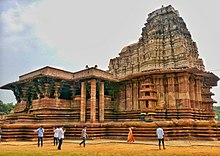
Ramappa Temple, also known as the Rudreshwara (Lord Siva) temple, is a UNESCO World Heritage Site located in the state of Telangana in southern India. It is 66 km (41 mi) away from Warangal, 15 km (9.3 mi) from Mulugu, 209 km (130 mi) from Hyderabad. It lies in a valley in Palampet village of Venkatapur mandal of Mulugu district, a tiny village long past its days of glory in the 13th and 14th centuries. An inscription in the temple dates it to the year 1213 CE and says it was built by a Kakatiya General Recharla Rudra, during the period of the Kakatiya ruler Ganapati Deva. The temple is a Sivalayam, where Lord Ramalingeswara is worshipped. Marco Polo, during his visit to the Kakatiya empire, allegedly called the temple "the brightest star in the galaxy of temples". Ramappa Temple stands majestically on a 6-foot (1.8 m) high star-shaped platform. The hall in front of the sanctum has numerous carved pillars that have been positioned to create an effect that combines light and space wonderfully. The temple is named after the sculptor Ramappa, who built it, and is perhaps the only temple in India to be named after a craftsman who built it. The main structure is in a reddish sandstone, but the columns round the outside have large brackets of black basalt which is rich in iron, magnesium and silica. These are carved as mythical animals or female dancers or musicians, and are "the masterpieces of Kakatiya art, notable for their delicate carving, sensuous postures and elongated bodies and heads". The Temple was included in the proposed UNESCO World Heritage Site "The Glorious Kakatiya Temples and Gateways", in 2019 on the "tentative list". The proposal was submitted to UNESCO on 10 September 2015. On 25 July 2021, the temple was inscribed as a World Heritage Site as "Kakatiya Rudreshwara (Ramappa) Temple, Telangana". There are two small Shiva shrines on either side of the main temple. The enormous Nandi within, facing the shrine of Shiva, remains in good condition. Nataraja Ramakrishna revived Perini Shivatandavam (Perini Dance), by seeing the sculptures in this temple. The dance poses, written in Nritta Rathnavalid by Jayapa Senaani, also appear in these sculptures. The temple remained intact even after repeated wars, plunder and destruction during wars and natural disasters. There was a major earthquake during the 17th century which caused some damage. It survived the earthquake due to its 'sandbox technique' of laying foundation. Many of the smaller structures were neglected and are in ruins. The Archaeological Survey of India has taken charge of it. The main entrance gate in the outer wall of the temple is ruined.